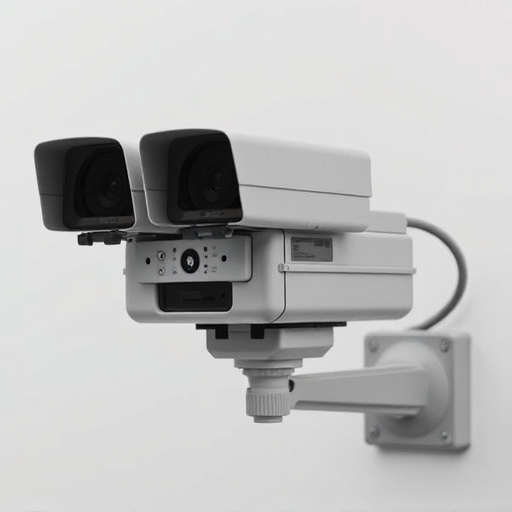Optimal dummy security camera height (1.8-2 meters) ensures clear footage. Consider surroundings, obstructions, and lighting for best placement. Follow guidelines for residential or commercial areas, surface types, weather conditions, and local laws. Align lens for wide field of view, test during day & night for optimal security & discreet appearance.
“Enhance your property’s security with an exterior fake CCTV system, a deterrent like no other. This guide provides essential instructions on mounting your dummy camera for optimal protection. From assessing your location for ideal camera placement and choosing the perfect height for maximum visibility to selecting suitable mounting techniques for diverse surfaces and weather conditions, we’ve got you covered. Learn how to align the camera lens for crystal-clear footage and test and adjust for peak performance while maintaining a discreet appearance using these dummy security camera height guidelines.”
- Assessing Your Location for Optimal Camera Placement
- Choosing the Right Height for Maximum Visibility
- Mounting Techniques for Different Surfaces and Weather Conditions
- Aligning the Camera Lens for Clear Footage
- Testing and Adjusting for Best Performance and Discreet Appearance
Assessing Your Location for Optimal Camera Placement
When assessing your location for optimal camera placement, consider both natural and man-made features that can either enhance or obstruct your view. The dummy security camera height guidelines recommend positioning cameras at eye level or slightly elevated to capture clear, unobstructed footage. Trees, buildings, or other tall structures nearby can affect the camera’s field of view, so assess their potential impact on the video quality.
Look for spots where the camera can have a wide angle of coverage without being unduly affected by ambient light or shadow. In residential areas, this might mean choosing a location above ground level to avoid obstructions from fences, bushes, or other landscaping features. Commercial properties may offer more flexibility in terms of mounting height and placement due to fewer restrictions from natural elements.
Choosing the Right Height for Maximum Visibility
When installing an exterior dummy security camera, one of the most crucial factors for maximum visibility and effectiveness is selecting the right height. According to dummy security camera height guidelines, mounting the camera at eye level or slightly elevated (around 5-10 feet above ground level) offers optimal viewing angles. This ensures that the camera captures clear, unobstructed images of the surrounding area, including potential intruders or suspicious activities.
Choosing a height that’s too low may result in blind spots and limited visibility, while mounting it too high can obscure important details. The ideal placement varies based on factors like the camera’s field of view, local laws, and the specific security needs of the property. Following these dummy security camera height guidelines will help ensure that your exterior surveillance system provides comprehensive protection and peace of mind.
Mounting Techniques for Different Surfaces and Weather Conditions
When mounting an exterior dummy security camera, understanding different surface types and weather conditions is crucial for optimal placement. For wooden or metal surfaces, screw mounts are suitable and secure. Use anchor screws if needed to prevent damage or wobble. Concrete walls require specific mounting brackets designed to withstand their weight and texture. In wet or humid environments, ensure the camera and its mount are rated for outdoor use and resistant to rust.
Consider wind exposure and temperature extremes when choosing a placement. Higher up is generally better to avoid damage from strong winds, but not too high that it’s inaccessible. The Dummy Security Camera Height Guidelines typically recommend placing cameras at eye level (around 1.8-2 meters or 6-7 feet) for the best field of view and deterrence effect. Always follow manufacturer instructions regarding mounting techniques and weatherproofing to ensure your camera provides reliable surveillance year-round.
Aligning the Camera Lens for Clear Footage
To ensure clear and concise footage, aligning the camera lens is a crucial step in mounting your exterior dummy security camera. Positioning it at the correct height and angle will greatly impact the quality of video captured. As a general guideline, the Dummy Security Camera Height should be approximately 1-2 meters above ground level to maintain optimal visibility while avoiding obstructions like trees or signs.
When installing, consider facing the lens towards the primary area you wish to monitor. Adjust the camera’s angle to capture a wide field of view without including unnecessary elements in the frame. Maintaining proper alignment will allow for clear identification and surveillance, ensuring the security camera effectively fulfills its purpose.
Testing and Adjusting for Best Performance and Discreet Appearance
After mounting your exterior fake CCTV camera, it’s crucial to test its performance and adjust for both optimal security and discreet appearance. Begin by verifying that the camera captures clear, high-resolution footage during daylight hours, ensuring it aligns with recommended Dummy Security Camera Height Guidelines for wide-angle coverage. Adjust the camera’s positioning or angle as needed to eliminate blind spots.
For nighttime surveillance, ensure the camera’s infrared LEDs activate automatically when ambient light levels drop below a certain threshold. Test its range and clarity in low-light conditions to guarantee effective motion detection and accurate identification. To maintain discreteness, pay close attention to the camera’s placement, aiming it towards areas requiring monitoring while keeping it out of plain sight.
When mounting an exterior dummy security camera, following these guidelines ensures optimal visibility and discreet appearance. By assessing your location, choosing the right height, selecting suitable mounting techniques for various surfaces and weather conditions, aligning the camera lens accurately, and testing your setup, you’ll achieve the best performance from your fake CCTV system while maintaining a realistic deterrent effect. Remember, the Dummy Security Camera Height Guidelines are crucial for maximizing both security and aesthetics.
